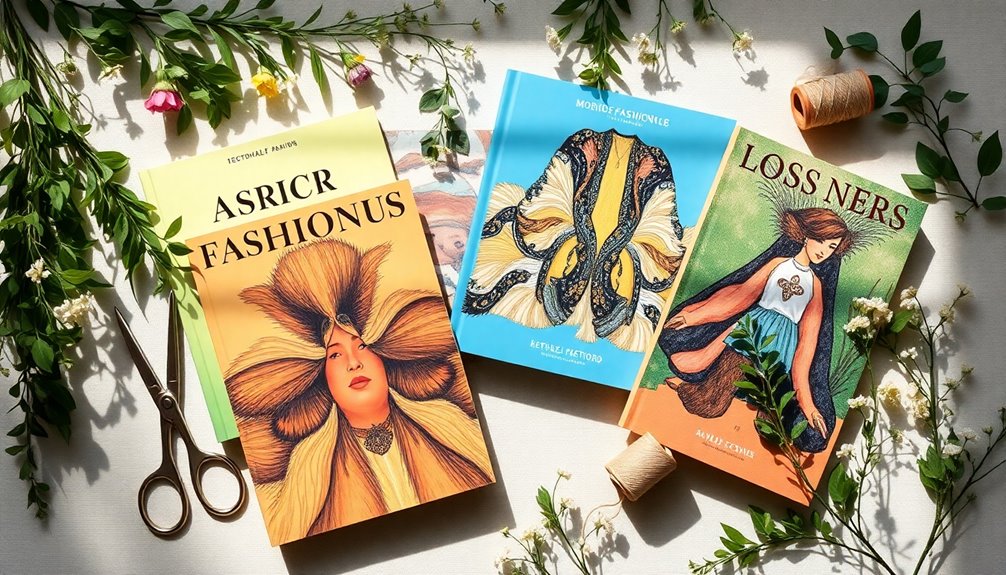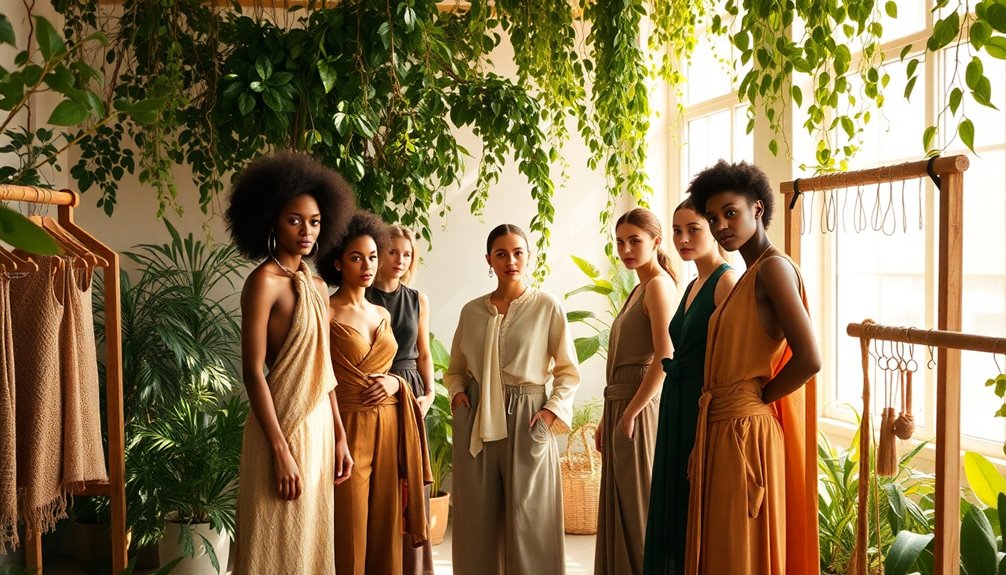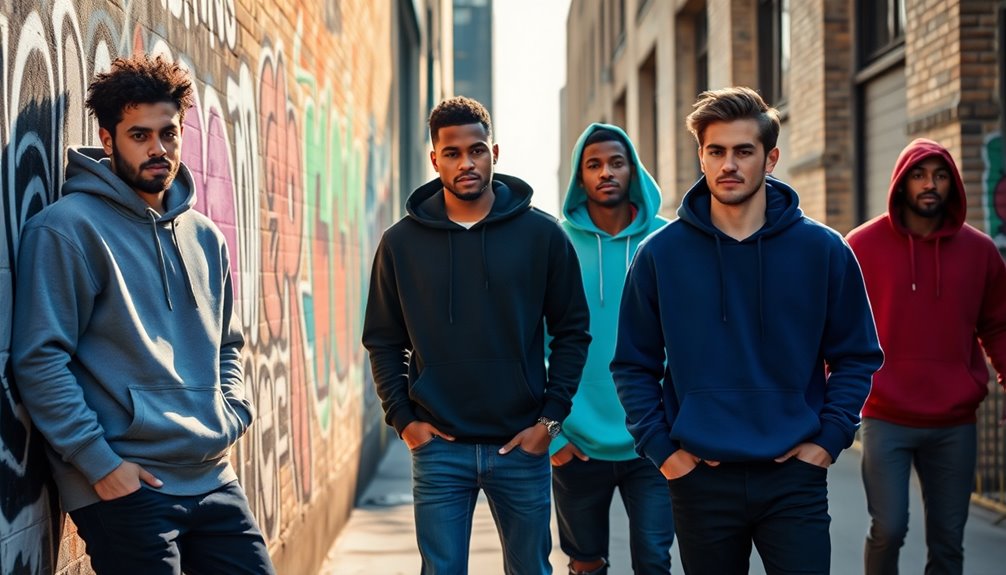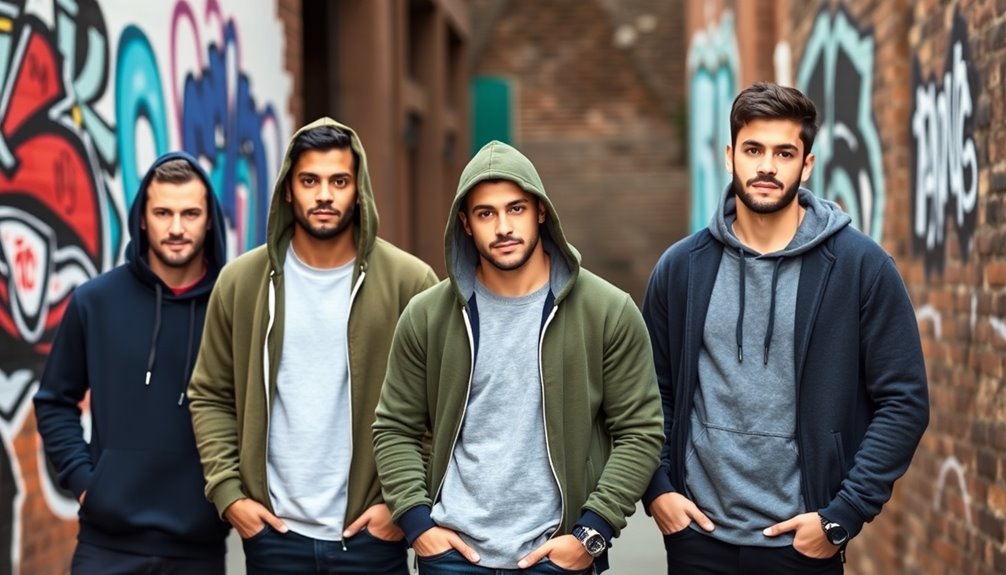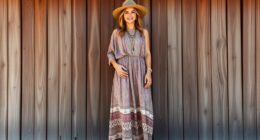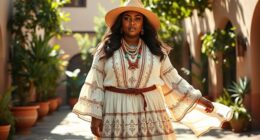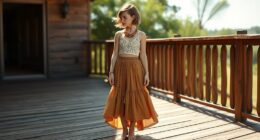If you're keen on transforming your wardrobe into an eco-friendly haven, I highly recommend exploring the world of sustainable fashion books. Titles like "Sustainable Fashion and Textiles" and "Fashionopolis" have absolutely changed my perspective on clothing choices. They offer insights into responsible consumption and innovative design methods that reduce environmental impact. Plus, they're filled with practical tips and engaging stories that make the concepts relatable. Whether you're new to sustainable fashion or a seasoned advocate, there's something in these books for everyone. Stick around, and you'll uncover even more fantastic resources to help inspire your green journey.
Key Takeaways
- Explore impactful titles like "Sustainable Fashion and Textiles" and "Fashionopolis" for insights on ethical practices and innovative movements in sustainable fashion.
- Seek books that provide practical advice on responsible consumption, garment care, and recycling strategies to inspire eco-friendly wardrobe choices.
- Look for engaging writing styles with personal stories and illustrations that make sustainable fashion concepts accessible to all readers.
- Consider resources that include exercises, case studies, and community engagement tips to deepen understanding and foster proactive involvement.
- Choose literature that critiques fast fashion while offering actionable solutions to encourage positive change in your fashion habits.
Sustainable Fashion and Textiles: Design Journeys
If you're someone who's passionate about sustainable design in fashion, "Sustainable Fashion and Textiles: Design Journeys" is definitely for you. This book has been a game-changer in the field, offering a thorough exploration of sustainability in fashion. The second edition is fully updated and dives deep into the lifecycle stages of textiles—from material cultivation to disposal.
What I love is how it encourages innovative thinking through its analysis of design approaches like service design and localism. It speaks to both academics and casual readers, making it a must-have for anyone interested in ethical fashion. Many readers rave about its insightful content, and I can see why; it's an essential read for anyone looking to understand sustainable practices in the industry.
Best For: Individuals passionate about sustainable design in fashion, including both professionals and students looking to deepen their understanding of ethical practices.
Pros:
- Thorough exploration of the lifecycle stages of textiles, providing comprehensive insights into sustainability.
- Encourages innovative thinking through discussions on design approaches like service design and localism.
- Accessible to a wide audience, catering to both academic readers and casual enthusiasts interested in ethical fashion.
Cons:
- May be too academic for casual readers seeking a lighter introduction to the topic.
- Some readers might find certain chapters dense or overwhelming due to the depth of information.
- The focus on sustainability might not appeal to individuals primarily interested in traditional fashion design practices.
The Future of Fashion: Understanding Sustainability in the Fashion Industry
For anyone enthusiastic to plunge into the world of sustainable fashion, "The Future of Fashion: Understanding Sustainability in the Fashion Industry" stands out as an essential read. This book provides a well-researched overview of why change is vital in the fashion industry and the environmental harm caused by current practices. It's accessible for both newcomers and those with some background, giving everyone valuable insights. I felt empowered after reading it, as it offers practical advice on making a difference in my shopping habits. Through personal accounts and solid data, the author highlights the innovative movements driving sustainability. This book truly inspires hope and illustrates that we all have a role in shaping the future of fashion.
Best For: Individuals looking to understand and engage with sustainable fashion practices, whether they are new to the topic or have some prior knowledge.
Pros:
- Provides a comprehensive overview of the environmental impact of the fashion industry.
- Offers practical advice empowering readers to change their shopping habits.
- Includes personal stories that showcase innovative movements toward sustainability.
Cons:
- May be less beneficial for readers already well-versed in sustainable fashion.
- The academic tone might be challenging for some casual readers.
- Limited in-depth exploration of specific sustainable brands or practices.
The Sustainable Fashion Handbook
The Sustainable Fashion Handbook stands out as an essential resource for anyone deeply invested in understanding the intricate issues of fashion sustainability. This thorough guide explores the complexities of clothing production, use, and disposal, shedding light on the environmental and social impacts of the fashion industry. I've found Sandy Black's collection of essays and interviews with industry leaders like Stella McCartney to be incredibly enlightening. The 307 illustrations, particularly the vibrant ones, enhance the reading experience. While some may bemoan its size, I appreciate the depth of information that challenges my buying habits and inspires eco-conscious choices. Quotes like "Buy less. Choose well" resonate with me, reminding me of the power of informed consumerism.
Best For: Individuals seeking a comprehensive understanding of fashion sustainability and its impact on the environment and society.
Pros:
- In-depth coverage of complex issues related to clothing production, use, and disposal.
- Features insights from industry leaders like Stella McCartney and Vivienne Westwood, enhancing the credibility of the content.
- Vibrant illustrations that enrich the reading experience and make the material more engaging.
Cons:
- The large size and weight of the book can make it less portable for casual reading.
- Some readers may find it overwhelming due to the depth and breadth of information presented.
- The physical attributes may be seen as a contradiction to its handbook title, limiting its practicality.
Sustainable Fashion: Responsible Consumption and Design
Sustainable Fashion Books are perfect for anyone passionate about making responsible choices in their wardrobe. They dive deep into the essence of sustainable fashion, highlighting the importance of responsible consumption and design. I've learned that it's not just about choosing eco-friendly materials, but also understanding the innovative production methods that can minimize environmental impact. As consumers, we now demand ethical practices from brands, pushing them to eliminate child labor and guarantee safe working conditions. These books showcase pioneering designers who integrate sustainability into their work, offering practical advice on garment care. For anyone looking to contribute positively to the fashion industry, this resource is a must-read, providing vital insights for designers, retailers, and conscious consumers alike.
Best For: Sustainable Fashion Books are best for individuals who are passionate about making responsible choices in their wardrobe and contributing positively to the fashion industry.
Pros:
- Promotes awareness: Offers valuable insights into sustainable practices and responsible consumption.
- Showcases innovation: Highlights pioneering designers and innovative production methods that reduce environmental impact.
- Practical guidance: Provides actionable advice for garment care and encourages ethical practices among consumers and brands.
Cons:
- Niche appeal: May not attract readers who are indifferent to sustainability or ethical fashion practices.
- Potentially limited scope: Some books may focus more on theory rather than offering extensive practical applications.
- Varied quality: The depth and quality of information can vary greatly between different sustainable fashion books.
Sustainable Fashion: What's Next
If you’re someone passionate about making a positive impact in the fashion industry, “Sustainable Fashion: What’s Next? ” is an essential read. This book dives deep into the pressing issues surrounding sustainability in fashion, featuring essays that highlight both challenges and opportunities. I found the discussions on organic agricultural practices and humane working conditions particularly eye-opening. The focus on recycling and circular economy concepts, especially cradle-to-cradle design, made me rethink my own consumption habits. The updated content, including practical case studies and thought-provoking discussion questions, encourages proactive engagement with sustainable practices. Plus, the additional resources, like videos and quizzes, enhance my understanding and application of the material. This book truly inspires me to envision a more sustainable future in fashion. I also appreciate the inclusion of examples of the best sustainable fashion collections, which serve as inspiration for both designers and consumers alike. The book’s comprehensive approach to sustainability in fashion has motivated me to seek out and support brands that prioritize ethical and eco-friendly practices. Overall, “Sustainable Fashion: What’s Next? ” is a valuable resource for anyone looking to make a positive impact in the fashion industry.
Best For: Individuals and professionals interested in understanding and implementing sustainable practices in the fashion industry.
Pros:
- Comprehensive insights into sustainability challenges and opportunities in fashion.
- Real-world applications and case studies that make concepts relatable and actionable.
- Additional educational resources such as quizzes and videos that enhance learning.
Cons:
- Potentially overwhelming for readers new to the topic due to the depth of information.
- May require a commitment of time to fully engage with all the provided resources.
- Limited focus on specific brands or products, which might not cater to all readers' interests.
Fashionopolis: Why What We Wear Matters
For anyone passionate about ethical fashion and the impact of their clothing choices, *Fashionopolis: Why What We Wear Matters* is an essential read. Dana Thomas dives deep into the clothing production chain, exposing the harsh realities of fast fashion. She critiques the devastating effects of offshoring on US manufacturing and shares chilling stories from countries like Bangladesh and Honduras. Yet, Thomas also shines a light on hopeful sustainable practices, showcasing brands that champion craftsmanship and ethical production. By tracing the evolution of fashion and consumer behavior, she urges us to make conscious choices. Ultimately, this book serves as a powerful call to action, encouraging us to dress with intention and consider the broader implications of our wardrobes for a sustainable future.
Best For: Individuals interested in understanding the ethical implications of their fashion choices and the impact of the clothing industry on society and the environment.
Pros:
- Engaging writing style that makes complex topics accessible and relatable.
- Highlights innovative sustainable practices and brands committed to ethical production.
- Encourages readers to make conscious consumer choices for a better future in fashion.
Cons:
- May be overwhelming for readers new to the issues surrounding fast fashion and sustainability.
- Some readers might find the critiques of fast fashion disheartening without immediate solutions.
- Focus on specific brands may limit the broader application of sustainable practices across the industry.
A Practical Guide to Sustainable Fashion (Basics Fashion Design)
A Practical Guide to Sustainable Fashion is an excellent resource for A level students, high-ability GCSE learners, and professionals alike, as it combines theoretical insights with practical applications. It dives deep into sustainable and ethical fashion, showcasing companies dedicated to responsible practices. The book highlights key issues in fashion design, from production to disposal, and provides step-by-step guidance on evaluating garment impacts. You'll appreciate the vibrant images from contributors like Vivienne Westwood and Stella McCartney. The final chapters focus on reducing negative impacts throughout the garment life cycle, covering techniques like upcycling and zero waste. With practical exercises on garment design and fabric sourcing, this guide equips you to create a more sustainable wardrobe.
Best For: A Practical Guide to Sustainable Fashion is best for A level students, high-ability GCSE learners, and professionals seeking to enhance their knowledge of sustainable and ethical fashion practices.
Pros:
- Provides a comprehensive overview of sustainable fashion concepts and practices.
- Includes vibrant images and contributions from renowned fashion figures.
- Offers practical exercises and industry perspectives for hands-on learning.
Cons:
- May require prior knowledge of fashion design for full comprehension.
- Focuses heavily on sustainability, which might not appeal to all fashion enthusiasts.
- Some readers might find the content dense or overwhelming without a background in the subject.
Fibershed: Growing a Movement for a New Textile Economy
Those passionate about reshaping the fashion industry through sustainable practices will find "Fibershed: Growing a Movement for a New Textile Economy" an invaluable resource. This book opened my eyes to the unsustainability of the current clothing industry and pushed me to rethink my clothing choices. I loved learning about local textile economies and how sourcing fibers nearby can mitigate the negative impacts of fast fashion. The author's personal journey—from knitting with linen to using locally sourced alpaca fleece—really inspired me. I also appreciated the emphasis on community engagement and economic justice, which made me realize the importance of supporting local fibersheds. If you're looking to build a more eco-friendly wardrobe, this book is a must-read!
Best For: Individuals interested in sustainable fashion and those looking to support local economies through eco-friendly clothing choices.
Pros:
- Promotes sustainable practices by encouraging local sourcing of fibers and reducing reliance on fast fashion.
- Inspires personal transformation through the author's journey and practical suggestions for creating heirloom-quality clothing.
- Fosters community engagement by highlighting the importance of local fibersheds and collaboration among artisans and consumers.
Cons:
- Geographic limitations may hinder some readers from easily accessing local fibersheds and materials.
- Potential higher costs associated with locally sourced fibers compared to mass-produced alternatives.
- Requires a mindset shift that may be challenging for those accustomed to fast fashion habits.
Traditionally Fermented Foods: Innovative Recipes and Techniques for Sustainable Eating
Emphasizing practical food preservation, "Traditionally Fermented Foods: Innovative Recipes and Techniques for Sustainable Eating" is perfect for anyone keen on embracing sustainable eating habits. Written by Shannon Stonger, this book blends innovative recipes with traditional fermentation techniques that can help us move away from reliance on modern canning and refrigeration. I love how Stonger shares her journey from chemistry to an agrarian lifestyle, making fermentation accessible even for beginners. With over 80 clear recipes, like Taco Kraut and Pizza Green Beans, the layout is user-friendly and encourages experimentation. The book's beautiful writing and practical advice have turned it into my go-to resource for sustainable food preservation. If you're interested in traditional methods, this book is a must-have!
Best For: Anyone interested in sustainable eating and traditional food preservation techniques, particularly beginners in fermentation.
Pros:
- Wide variety of recipes: Over 80 innovative and traditional recipes that cater to different tastes and dietary needs.
- User-friendly layout: The book's design allows it to lay flat, making it easy to follow recipes while cooking.
- Informative and engaging writing: Shannon Stonger's personal journey and clear explanations make fermentation accessible and enjoyable.
Cons:
- Minor shipping issues: Some readers reported problems such as water damage during shipping.
- Limited focus on advanced techniques: While it's great for beginners, more experienced fermenters might seek additional advanced recipes or methods.
- Potential ingredient accessibility: Some specialty ingredients may not be easily available to all readers, depending on their location.
Wear, Repair, Repurpose: A Makers Guide to Mending and Upcycling Clothes
For anyone looking to plunge into sustainable fashion, "Wear, Repair, Repurpose: A Makers Guide to Mending and Upcycling Clothes" is an invaluable resource. Lily Fulop's book offers straightforward, step-by-step instructions paired with vibrant illustrations, making it perfect for beginners like me. I've tackled projects such as hemming pajama pants and mending jeans, gaining confidence along the way. The creative ideas range from repairing socks to repurposing fabric into unique items like braided rugs. Plus, it encourages using materials I already have at home, which is a bonus. The book's beautiful design and engaging aesthetics inspire me to embrace a more sustainable wardrobe. While it may not explore deeply for experienced crafters, it's a fantastic starting point for anyone interested in mending and upcycling.
Best For: Beginners and those seeking to adopt sustainable practices in fashion through mending and upcycling.
Pros:
- Step-by-step instructions make it easy for newcomers to learn and apply sewing techniques.
- Creative project ideas encourage users to repurpose materials they already have at home, promoting sustainability.
- Beautiful design and illustrations enhance the overall learning experience and inspire readers to engage with the content.
Cons:
- May lack depth for experienced crafters looking for advanced techniques and projects.
- Some instructions may be unclear in certain areas, leading to potential confusion.
- Limited appeal for those seeking more comprehensive resources on sewing and crafting.
The Conscious Closet: A Guide to Sustainable Fashion
If you're looking to make a positive impact through your wardrobe choices, "The Conscious Closet: A Guide to Sustainable Fashion" by Elizabeth L. Cline is a must-read. This book dives deep into the hidden costs of fast fashion, urging us to rethink our consumption habits. I found the practical tips incredibly helpful, like engaging in low buy challenges and creating capsule wardrobes. Cline emphasizes the importance of shopping resale and thrift, which not only saves money but also promotes sustainability. The statistics she shares about pollution and exploitation in the industry are eye-opening. Most importantly, it inspires us to connect and act as a community for change. It's a powerful guide that encourages us to transform our wardrobes and the fashion industry for good.
Best For: Individuals looking to create a sustainable wardrobe and reduce the negative impact of fast fashion on the environment and society.
Pros:
- Practical tips for implementing sustainable fashion practices, making it easy for readers to take actionable steps.
- Engaging writing style that combines personal stories with research, keeping readers motivated and informed.
- Community focus, encouraging readers to connect and participate in movements for change within the fashion industry.
Cons:
- Some readers may find repetitive content, which could detract from the overall reading experience.
- The emphasis on second-hand shopping may overshadow other sustainable alternatives to fast fashion.
- Limited focus on addressing broader industry solutions, which might leave some readers wanting more comprehensive strategies.
Back to Basics: A Complete Guide to Traditional Skills
Looking to embrace a simpler, more self-sufficient lifestyle? "Back to Basics: A Complete Guide to Traditional Skills" is your go-to resource. With over 200,000 copies sold, this extensive guide covers everything from gardening and woodworking to canning and raising chickens. I found the step-by-step instructions and illustrations incredibly helpful for diving into traditional skills. Whether you're a beginner or already living the homestead life, there's something for everyone. You'll also discover recipes and crafts that cater to both practical needs and creative pursuits. While some readers noted issues with physical copies and regional content, the overall satisfaction highlights its value. This book is a treasure trove that inspires not just skills, but a healthier, greener lifestyle.
Best For: Individuals seeking to learn traditional skills and embrace a simpler, self-sufficient lifestyle, whether beginners or experienced homesteaders.
Pros:
- Comprehensive coverage of a wide range of traditional skills, from gardening to woodworking.
- Clear step-by-step instructions and helpful illustrations that make learning accessible.
- Encourages creativity with recipes and crafts along with practical skills.
Cons:
- Some readers experienced issues with the physical condition of their copies upon arrival.
- Certain content may be overly focused on American practices, limiting applicability for international readers.
- A few mentions of outdated information, which could affect relevance for some projects.
The Encyclopedia of Country Living, 50th Anniversary Edition
The Encyclopedia of Country Living, 50th Anniversary Edition, stands out as an invaluable resource for anyone enthusiastic to embrace a self-sufficient lifestyle. With over 1,000 pages packed with essential country skills, it's perfect for homesteaders and urban farmers alike. I love how it's organized like an encyclopedia, making it easy to find information on gardening, food preservation, and even cheese making. The achievement checklists help me track my progress and identify areas to improve. While some readers wish for more visuals, the wealth of practical knowledge is undeniable. This book empowers me to prepare for emergencies and encourages a deeper connection with nature. It's truly a foundational resource for anyone wanting to cultivate a sustainable lifestyle.
Best For: Individuals seeking to embrace a self-sufficient lifestyle through practical homesteading skills and sustainable living practices.
Pros:
- Comprehensive coverage of essential country skills, making it a valuable resource for homesteaders and urban farmers.
- User-friendly layout with achievement checklists that help track progress and identify areas for improvement.
- Encourages proactive preparation for emergencies and fosters a deeper connection with nature.
Cons:
- Some readers may find the lack of pictures and diagrams a drawback, limiting visual learning.
- A color version is not available, which could enhance the reading experience for some users.
- The extensive content may be overwhelming for beginners who are just starting their self-sufficient journey.
Old-Fashioned Jams, Jellies, and Sweet Preserves Guide
For anyone passionate about preserving the flavors of seasonal fruits, Jo Ann Gardner's "Old-Fashioned Jams, Jellies, and Sweet Preserves" is an invaluable resource. With nearly four decades of farming experience, Jo Ann shares her extensive gardening knowledge through this updated edition. The book not only offers seventy-five delicious recipes for jams and jellies but also provides environmentally sound directions for growing, harvesting, and canning. I love how it covers a variety of fruits, from classic strawberries to unique elderberries, making it suitable for both experienced cooks and beginners. Readers rave about the informative content and practical recipes, making it a perfect gift for anyone looking to immerse themselves in the world of homemade preserves. You'll definitely find inspiration in these pages!
Best For: Anyone passionate about homemade preserves, from novice cooks to experienced food enthusiasts looking to enhance their canning skills.
Pros:
- Informative content that combines horticultural knowledge with practical cooking techniques.
- Variety of recipes featuring both common and unique fruits, catering to diverse tastes.
- Environmentally sound guidance on growing and preserving fruits, promoting sustainable practices.
Cons:
- Some readers may find certain recipes challenging if they lack prior canning experience.
- Not every recipe may suit individual preferences, as taste varies among readers.
- The book's focus on specific fruits might limit options for those seeking a wider variety of preserves.
Wardrobe Crisis: How We Went from Sunday Best to Fast Fashion
If you're someone who's passionate about fashion yet deeply concerned about its environmental impact, "Wardrobe Crisis: How We Went from Sunday Best to Fast Fashion" is a must-read. Clare Press takes us on a journey through the history of fashion, revealing how we shifted from cherished craftsmanship to a throwaway culture. She dives into the staggering $1.5 trillion global fashion industry, exposing its sustainability issues and urging us to rethink our shopping habits. With her engaging style, Press balances her love for fashion with a critical look at its flaws. This book inspires us to embrace ethical practices and make informed choices, ultimately advocating for a fashion revolution that respects both people and the planet. Trust me, you won't want to miss this.
Best For: Individuals who are passionate about fashion and want to understand its environmental and ethical implications.
Pros:
- Engaging writing style that makes complex issues accessible and enjoyable to read.
- Invaluable insights into the history of fashion and its impact on sustainability, prompting thoughtful reflection.
- Encourages ethical consumerism, inspiring readers to adopt more mindful shopping habits.
Cons:
- Some readers may find the political leanings of the book to be a bit strong or off-putting.
- A few typographical errors can detract from the overall reading experience.
- Focus on historical narratives may overshadow current consumerism issues for some readers.
Factors to Consider When Choosing Sustainable Fashion Books

When I choose a sustainable fashion book, I look closely at the author's expertise and background to guarantee I'm learning from a credible source. I also consider how practical the concepts are, as I want to apply them in my own life. Finally, I pay attention to the depth of research and visual aids in the book, which can really enhance my understanding of the topic.
Author Expertise and Background
Choosing the right sustainable fashion book starts with examining the author's expertise and background. I always look for authors who have a solid professional background in fashion, sustainability, or related fields. This expertise can enhance the credibility and depth of the content. For me, it's especially beneficial when authors have hands-on experience in the fashion industry as designers or consultants; they often provide invaluable firsthand insights into sustainable practices that you won't find elsewhere.
Additionally, I appreciate authors who are engaged in social movements or educational initiatives related to sustainability. Their involvement often leads to a more thorough understanding of the issues at hand. I also pay attention to an author's research credentials, including their published works or contributions to academic discussions on sustainable fashion. This can indicate a well-informed perspective that resonates with me.
Lastly, I enjoy when authors blend personal narratives with researched data. It creates a relatable yet informative reading experience, bridging the gap between theory and practical application. By focusing on these aspects, I make certain that the books I choose are not only informative but also inspiring for my eco-friendly wardrobe journey.
Practical Application of Concepts
Understanding the author's expertise lays a solid foundation, but the real value of sustainable fashion books comes from their practical application of concepts. When I choose a book, I focus on those that provide clear guidance on evaluating garment impacts and incorporating eco-friendly materials into my design choices. Books that offer step-by-step instructions for mending, upcycling, and using low-impact textiles really resonate with me. They make sustainable practices feel accessible and actionable.
I also look for titles that include case studies or real-world applications, as these examples illustrate how sustainable principles can be woven into everyday fashion decisions and industry practices. It's inspiring to see how others have successfully integrated these concepts into their lives.
Moreover, I appreciate resources that emphasize actionable tips for responsible consumption, like techniques to extend the lifespan of clothing through proper care and maintenance. Finally, I seek out discussions on innovative design approaches, such as zero waste techniques and closed-loop systems, to deepen my understanding of sustainable fashion's practical implications. Choosing the right books can truly empower me to make informed, eco-friendly choices in my wardrobe.
Target Audience and Accessibility
Sustainable fashion books target a wide audience, catering to everyone from seasoned academics to casual enthusiasts. If you're just dipping your toes into sustainable fashion, you'll find many titles designed as introductory texts. These books break down complex ideas and present them in an engaging way, making it easier to understand the movement. For those already familiar with the subject, there are in-depth insights that can enhance your knowledge and inspire new perspectives.
When choosing a book, consider its writing style. Some authors adopt an academic tone, while others use a conversational approach. Finding a book that aligns with your preferences can make all the difference in how you engage with the material. Additionally, many sustainable fashion books include practical advice and actionable steps, which is a huge plus if you're looking to implement changes in your wardrobe.
You'll also appreciate that many authors include personal stories, case studies, and interviews with industry figures. These narratives help to make complex themes more relatable and engaging, ensuring that there's something for everyone in the world of sustainable fashion literature.
Depth of Research Provided
A solid foundation in sustainable fashion requires a careful examination of the depth of research provided in the books you consider. I always look for texts that offer high-quality research and statistical data, which really illustrate the industry's environmental impact and current trends. It's essential to choose books featuring contributions from diverse authors, such as designers and academics, to guarantee a well-rounded exploration of sustainability issues within fashion.
Books that include case studies and personal accounts are especially valuable, as they offer practical insights into innovative practices and movements making a difference in sustainable fashion. I find that the depth of analysis regarding the lifecycle of garments—from production to disposal—significantly enhances my understanding of sustainable practices and the importance of responsible consumption.
Moreover, I appreciate books that not only critique existing practices but also propose actionable solutions and future directions for sustainable fashion. This encourages me to engage with the material critically and apply what I learn to my own wardrobe choices. By focusing on these elements, I can better navigate the landscape of sustainable fashion and inspire others to do the same.
Visual Aids and Illustrations
Visual aids and illustrations play an essential role in my exploration of sustainable fashion books. They enhance my understanding by providing clear examples of concepts like eco-friendly materials and design techniques. When I come across books that incorporate vibrant photographs and diagrams, I find my engagement increases markedly. These visuals make complex topics much more accessible, regardless of my prior knowledge.
For instance, high-quality illustrations in *The Sustainable Fashion Handbook* effectively highlight the lifecycle of garments and their environmental impact. Infographics and visual summaries also catch my eye, distilling essential data and statistics that reveal the industry's sustainability challenges at a glance. This makes a huge difference when I want to grasp important information quickly.
Additionally, I appreciate the presence of step-by-step visual guides in practical sustainable fashion books. They facilitate hands-on learning, especially when I'm interested in mending, upcycling, or designing garments responsibly. Overall, the effective use of visuals not only enriches the reading experience but also empowers me to make informed, eco-friendly fashion choices.
Coverage of Key Topics
When I immerse myself in sustainable fashion books, I focus on coverage of key topics that truly matter. First, I look for books that investigate the lifecycle stages of fashion—material cultivation, production, use, and disposal. Understanding these stages is vital for grasping the full impact of clothing on our planet.
I also consider texts that explore innovative design approaches, such as service design and localism. These concepts are essential for altering consumption patterns and promoting sustainability. Practical advice on responsible consumption and garment care is another important aspect; it empowers me to make informed choices in my fashion practices.
Moreover, I seek books backed by high-quality research and statistical data. This evidence-based approach helps ground my understanding of the environmental impact of the fashion industry. Finally, works featuring personal accounts and case studies resonate with me. They illustrate real-world applications of sustainable practices and inspire me to engage in the movement for more ethical fashion. By focusing on these key topics, I guarantee that the books I choose truly contribute to my journey toward a more sustainable wardrobe.
Engagement and Writing Style
Choosing sustainable fashion books isn't just about the content; the engagement and writing style play an essential role in how effectively the message resonates with me. I've found that authors who adopt a conversational and relatable tone make complex topics more accessible, which keeps me engaged. Books that weave personal narratives alongside educational content truly stand out. These stories create emotional connections that enhance my learning experience, making the material not only informative but also memorable.
Visual elements, like colorful illustrations and striking photographs, add to the aesthetic appeal of these books, inspiring me even further. I appreciate when a book is well-organized, featuring chapter summaries and discussion questions; this structure helps clarify concepts and encourages critical thinking. It's also vital for me to find books that blend research with practical advice. This combination not only informs me about sustainability issues but empowers me to adopt actionable steps in my own wardrobe. Overall, when I choose a sustainable fashion book, I look for a balance of engaging writing, compelling visuals, and practical insights that inspire my journey toward a more eco-friendly lifestyle.
Frequently Asked Questions
How Can I Start My Sustainable Fashion Journey on a Budget?
Starting my sustainable fashion journey on a budget was easier than I thought. I began by decluttering my closet, donating items I no longer wore. Then, I explored thrift stores and online resale platforms, discovering unique pieces at great prices. I also learned to upcycle old clothes into something fresh and new. By prioritizing quality over quantity, I've built a wardrobe that's both stylish and eco-friendly without breaking the bank. It's been rewarding!
Are There Online Resources for Sustainable Fashion Beyond Books?
Absolutely, I've found plenty of online resources for sustainable fashion beyond just books. Websites like Eco Warrior Princess and The Good Trade offer articles, guides, and tips that really help me stay informed. Social media platforms, especially Instagram and Pinterest, are goldmines for inspiration. I follow eco-conscious influencers who share their journeys and brands. Plus, YouTube has some fantastic channels dedicated to sustainable fashion, making it easy to learn while I explore my style.
What Are the Key Principles of Sustainable Fashion?
When I think of sustainable fashion, I picture a tree deeply rooted in the earth, symbolizing growth and resilience. The key principles include using eco-friendly materials, reducing waste, and prioritizing ethical labor practices. It's about creating a wardrobe that respects the planet and its people. I've learned that investing in quality over quantity can make a significant difference, allowing us to cultivate a more conscious relationship with our clothing choices.
Can I Find Sustainable Fashion Brands That Cater to Plus Sizes?
Absolutely, you can find sustainable fashion brands that cater to plus sizes! I've discovered several brands that focus on inclusivity while prioritizing eco-friendly practices. Brands like Universal Standard and Reformation offer stylish options that embrace diverse body shapes. It's encouraging to see the industry shifting towards sustainability and better representation. I always feel more confident when I wear clothes that not only fit well but also align with my values.
How Do I Properly Recycle or Dispose of Old Clothing?
Did you know that over 92 million tons of textile waste end up in landfills each year? To properly recycle or dispose of old clothing, I always check for local recycling programs or clothing banks. Many organizations accept used garments, even if they're damaged. If clothing is beyond repair, I cut it into rags or use it for DIY projects. Remember, every little effort counts in reducing waste and protecting our planet!
Conclusion
As you commence your journey towards a more sustainable wardrobe, these books serve as your guiding stars, illuminating the path to conscious choices. They gently nudge you away from the whirlwind of fast fashion, inviting you to embrace the beauty of mindful consumption. With each page, you'll discover the artistry and ethics woven into sustainable fashion, transforming your closet into a tapestry of eco-friendly elegance. So, let's turn the page together and step gracefully into a greener future.
